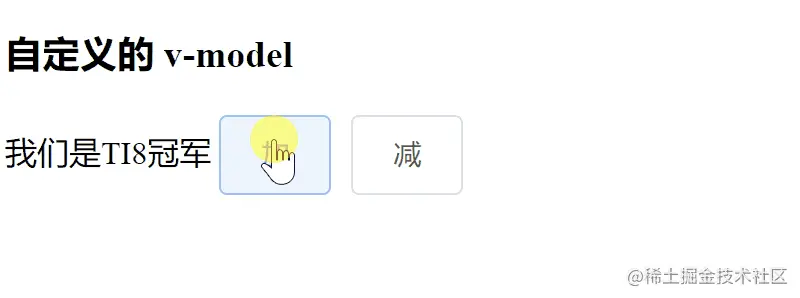Home > Article > Web Front-end > Take you to have an in-depth understanding of v-model in vue2 and see how to make components support this syntax
This article will take you to understand v-model in vue2, see whether v-model is two-way binding or one-way data flow, and how to make the components you develop support v-model. I hope it will be helpful to everyone.

You will:
v-model Syntactic sugar? vue2 What special processing has been done to native components? v-model Is it one-way data flow or two-way data binding? v-model What are the "side effects" beyond syntactic sugar? v-model syntax. v-model is syntactic sugar. 『
v-modelis essentially just syntactic sugar. It is responsible for listening to user input events to update data and perform some special processing for some extreme scenarios. 』 --Official documentation. [Related recommendations: vue.js tutorial]
What is syntactic sugar?
Syntax sugar, simply put, is "convenient writing".
In most cases, v-model="foo" is equivalent to :value="foo" plus @input ="foo = $event";
<!-- 在大部分情况下,以下两种写法是等价的 --> <el-input v-model="foo" /> <el-input :value="foo" @input="foo = $event" />
Yes, in most cases this is true.
But there are exceptions:
vue2 provides the model attribute to the component, allowing users to customize The prop name of the passed value and the event name of the updated value . I’ll skip this for now and will go into details in Section 4.
For native html native elements, vue has done a lot of "dirty work" in order to make us ignore it html Differences in API. The left and right writing methods of the following elements are equivalent:
textarea Element: select Drop-down box: Radio button:

. 2. Is v-model just syntactic sugar? (Trivia)
v-modelIfis not only syntactic sugar, it also has side effects.
The side effects are as follows:
v-model is bound to a property that does not exist on the responsive object, then vue will quietly Simply add this property and make it responsive. For example, look at the following code:
// template中:
<el-input v-model="user.tel"></el-input>
// script中:
export default {
data() {
return {
user: {
name: '公众号: 前端要摸鱼',
}
}
}
}The
user.tel attribute is not defined in the responsive data, but the template But v-model is used to bind user.tel. Guess what happens when you enter? See the effect:
 Reveal the answer:
Reveal the answer:
attribute will be added to user , and tel this attribute is still responsive. This is the effect of "side effects", have you learned it?
3.
v-model『You can use the v-model directive in forms
, <textarea></textarea> and <select></select> Create two-way data binding on the element. 』——vue2 official document2.2 Is
Although the official did not clearly state this, we can figure out the relationship between the two.What is a single data flow?
attribute passed to it by the parent component. The recommended approach is for it to throw an event and notify the parent component to change the bound value on its own.
The approach is completely consistent with single data flow. Even more, it provides a specification on naming and event definition. <p>众所周知 <code>.sync 修饰符是单向数据流的另一个典型范式。
『单向数据流』总结起来其实也就8个字:『数据向下,事件向上』。
v-model
虽然不想说,但这确实是高频面试题。
在定义 vue 组件时,你可以提供一个 model 属性,用来定义该组件以何种方式支持 v-model。
model 属性本身是有默认值的,如下:
// 默认的 model 属性
export default {
model: {
prop: 'value',
event: 'input'
}
}也就是说,如果你不定义 model 属性,或者你按照当面方法定义属性,当其他人使用你的自定义组件时,v-model="foo" 就完全等价于 :value="foo" 加上 @input="foo = $event"。
如果把 model 属性进行一些改装,如下:
// 默认的 model 属性
export default {
model: {
prop: 'ame',
event: 'zard'
}
}那么,v-model="foo" 就等价于 :ame="foo" 加上 @zard="foo = $event"。
没错,就是这么容易,让我们看个例子。
先定义一个自定义组件:
<template>
<div>
我们是TI{{ ame }}冠军
<el-button @click="playDota2(1)">加</el-button>
<el-button @click="playDota2(-1)">减</el-button>
</div>
</template>
<script>
export default {
props: {
ame: {
type: Number,
default: 8
}
},
model: { // 自定义v-model的格式
prop: 'ame', // 代表 v-model 绑定的prop名
event: 'zard' // 代码 v-model 通知父组件更新属性的事件名
},
methods: {
playDota2(step) {
const newYear = this.ame + step
this.$emit('zard', newYear)
}
}
}
</script>然后我们在父组件中使用该组件:
// template中
<dota v-model="ti"></dota>
// script中
export default {
data() {
return {
ti: 8
}
}
}看看效果:

让你的组件支持 v-model 就这么容易。
获取源码请访问github
https://github.com/zhangshichun/blog-vue2-demos/tree/master/src/views/about-v-model
更多编程相关知识,请访问:编程视频!!
The above is the detailed content of Take you to have an in-depth understanding of v-model in vue2 and see how to make components support this syntax. For more information, please follow other related articles on the PHP Chinese website!